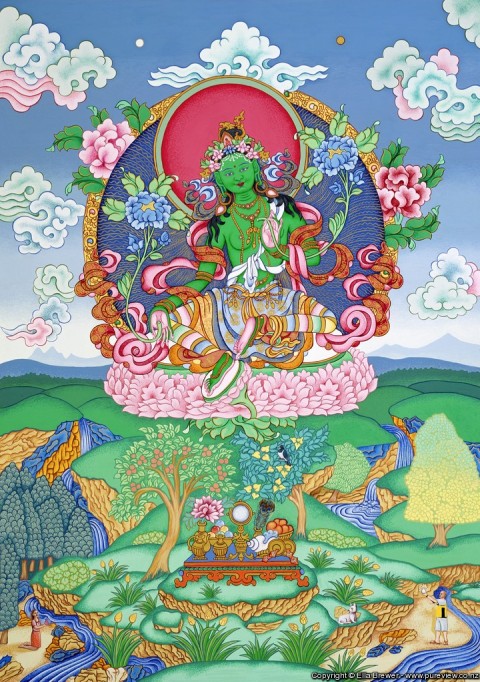Of all the graduate institutions in the world, I chose the California Institute of Integral Studies (CIIS) in San Francisco because of its unique program in Women’s Spirituality. Only here could I integrate my love of the Goddess Tara, my spiritual practice of Tibetan Buddhism, and my passion to chant into a scholarly study titled “Invoking the Blessings of the Tibetan Buddhist Goddess Tara Through Chanting Her Mantra to Overcome Fear.”
I conducted my research in the summer of 2008. Fortunately, I was able to draw from the many academic, contemplative, and spiritual groups of my acquaintance in the San Francisco Bay Area to solicit study co-participants. Over the course of three months, we convened on six occasions to meditate, pray, and chant to Tara with the intention of overcoming a particular fear. Between our meetings, we chanted on our own and kept a journal about what we were experiencing.

The Tibetan Buddhist Goddess Tara’s mantra is OM TARE TUTARE TURE SOHA!
Om is “the goal of the path”
Tare is Tara, “she who liberates us from suffering”
Tutare means “she who eliminates all fears”
Ture is “she who grants all successes”
Soha reminds us to rejoice as the mantra takes “root in our hearts.”
Tara is reputed to save beings from fear, particularly the eight great fears. These eight great fears are symbolically represented and may more accurately reflect the obstacles (or negative emotions) that prevent us from reaching our highest potential:
Symbolic Fear |
Inner Obstacle |
| Fear of lions | Pride |
| Fear of elephants | Ignorance |
| Fear of fire | Anger |
| Fear of snakes | Jealousy |
| Fear of robbers | Distorted views |
| Fear of imprisonment | Miserliness |
| Fear of floods | Attachment |
| Fear of demons | Doubt |
Since fear is often a source of suffering, it was my hope that we study co-participants would experience a lessening or diminishment of fear, at best, and, at the least, would be subjected to the positive encounter of meditation and chanting. In other words, I sought to alleviate the suffering of other sentient beings through chant.
To accomplish my study’s aim, I used the participatory research methodological approach outlined by the eco-philosopher Henryk Skolimowski. He defines his approach as both Buddhist and feminist because it is concerned with the true nature of our minds and recognizes all knowledge as value-laden.
Buddhism devotes itself to understanding the mind, which is infinite, clear, and a limitless resource. While feminism reminds us that all thought is subjective and, therefore, value-laden, even while pretending to be objective whether this be the notion that some ways of knowing are more valid than others or that some types of people and lifestyles are of more importance than others. In Skolimowski’s Participatory Research, he counsels an approach to the divine that validates our co-creation with our universe and acknowledges our many ways of communing with deity.
Through this communion produced by mediation, chant, altar building, visualization, and desire, the study co-participants kept journals I later analyzed by use of Grounded Theory as defined by Kathy Charmaz. This produced themes and sub-themes that formed a picture of what the co-participants experienced during the study. These themes were: fear, the experience of chanting, control issues, feelings and emotions, Tara, relationships, energy, sleep and dreams, empowering, and writing. Our experiences as co-participants led me to believe that much of what we fear involves love. This was often expressed as a fear of making ourselves vulnerable to love through wanting it and not having it or, conversely, having it and fearing being hurt by it.
All the study co-participants expressed a lessening of their fear through the experience of participating in the study. However, this lessening may not be completely attributable to the chanting of Tara’s mantra. Other ameliorating factors may have been attending to the fear rather than ignoring it and hoping it would go away, and time and distance from the immediate source of fear. An important result of the study was that no one was harmed and the co-participants now have a tool to help them overcome fear, and hopefully lessen their suffering.
Karen Nelson Villanueva has recently successfully defended her doctoral dissertation, “Invoking the Blessings of the Tibetan Buddhist Goddess Tara through Chanting Her Mantra to Overcome Fear,” at the California Institute of Integral Studies. She leads Tara Pujas, meditation, and teaches introductory-level Buddhism at the Tse Chen Ling Center for Tibetan Buddhist Studies in San Francisco, California.



The same with FAR, participating in a group, not entirely going it alone, became part of the solution.
LikeLike
Really interesting! Thanks.
LikeLike
Thank you for your comments, Sarah and Peg. It is always nice to be supported by community.
LikeLike
Hello, it’s my pleasure to pay my heart ful gratitude to you for doing such interesting and wonderful works about goddess Tara (dolma). You are really great for me for spreading news about goddess Tara to the world and m sure most of the people will follow goddess Tara to overcome any obstacles. I can say u are goddess Tara to me for your love and interest in her. M always praying to her and considered goddess Tara as my past, present and future god. Thank you! Please send me copy of your works that u have done on goddess Tara in my personnel email kinley15july@gmail.com
LikeLike
Thank you for your ver kind and supportive words, Kinley. I have published my dissertation as open access and expect it to be available through a web link very soon. When I get this link, I’ll be sure to forward it to you. I’m your sister in Taa Love, Karen
LikeLike
This is excellent. I’ve been devoted to Green Tara since the late 80s, when I attended a teaching with Dagmola Jamyang Sakya. I was the only pagan in a room full of WASP Tibetans (you know–white people who chant and prostrate and do so with great respect and dignity), and you know what? I was totally accepted. I don’t do any kind of Tibetan ceremony, but I have Taras all over my house, both green and white. My devotion to Tara is one of the few things I don’t parody.
Do you know Prema and the other women who do the Tara dancing around the world? I danced with them once. I didn’t even bump into other people. It was a lovely experience.
Bright blessings!
LikeLike
I appreciate this article. I have a very nebulous idea of Tara but have an instinctive affinity with the White Tara, or Sitatara. I didn’t know She could be a Goddess. I believe She’s a Boddhisatva. If there isn’t any difference, excuse my ignorance.
LikeLike
Yes, Barbara. I have had the honor of dancing the 21 Taras with Prema and living in the Bay Area, I am close to a group that meets to dance regularly. Also, I maintain a devotion to Tara #17, Sukha Sadhana Tara, She Who Accomplishes Happiness. As you note, it was a lovely experience.
LikeLike
Hi Petrujviljoen, Tara is a Goddess, which is a translation of the Tibetan word lhamo (Divine Mother), and all of her manifestations are also divine. As White Tara her mantra is OM TARE TUTTARE TURE MAMA AYUH PUNYA JNANA PUSHTIM KURU YE SOHA! The meaning of this mantra is roughly: Divine Mother, Bless me to increase my life, increase my health, wisdom, and success. For this reason, you often find many older Tibetans attending White Tara pujas.
Tara is also a Buddha, a fully enlightened being. Bodhisattvas are beings who are trying to become Buddhas because they want to help all sentient beings to achieve happiness and enlightenment, and they accomplish this through working on the six perfections (paramitas): generosity, concentration, patience, joyful effort, morality, and wisdom.
Some people mistakenly call Tara a Bodhisattva because she is adorned with jewels and silks, but every Goddess must celebrate her temple through adorning herself in beauty.
I hope this was helpful. ~Karen
LikeLike
Although Tara is not among my primary goddesses, She still has a place in my heart. In fact, I recorded one of Her chants on my CD “Chants for the Queen of Heaven…and Earth.”
Your study reminds me of a Starhawk chant that has been helpful in my life:
“Where there’s fear, there is power./Passion is the healer./Desire cracks open the gate./When you’re ready it will take you through.” I think of passion as encompassing love and compassion as well as the narrow definition of passion as ardent love or sexual desire, so this Chant is similar to your research outcome that fear is often connected with love.
LikeLike
Thank you, Nancy. I appreciate the information you have given me. I will check out your CD and the Starhawk quote.
LikeLike
I really enjoyed the blend of the scholarly with the spiritual in your post. I also got a lot out of the comments and your replies. It’s motivating me to dive further into Tara as a Goddess and see what She holds for me. Thank you for sharing! Blessings! :)
LikeLike
Your comment inspires me to continue my work! Thank you!
LikeLike
Dear Friend:
Congratulation in your work. May Tara continue to inspire you and support you gently.
leopoldo
LikeLike
I appreciate you stopping by and checking out my blog post, Leopoldo. I hope I see you again soon.
LikeLike
Thank you for this wonderful post, and for sharing further insights about Tara with us. Green Tara has center position on my altar and guides me with Her loving flow through each day. Blessings!
LikeLike
You’re very welcome, Darla. I’m delighted that you enjoyed my post.
LikeLike
I had not heard of Tara before this, but do know a lot about fear! Thank you. I look forward to learning more and befriending this goddess.
LikeLike
You’re very welcome, Barbara!
LikeLike
Here’s a link for my dissertation: http://gradworks.umi.com/36/06/3606937.html
Enjoy!
Karen
LikeLike
Thank you for sharing your dissertation. I look forward to reading it once this semester is finished. Blessings!
LikeLike
If you read my 307 pages, then you are too kind, Darla! Have a great rest of the semester!
LikeLike
Hi Karen
This is so lovely. I am looking for ways to invoke and inviteTara in my life and would love to read your dissertation. It sounds so wonderful :)
LikeLike